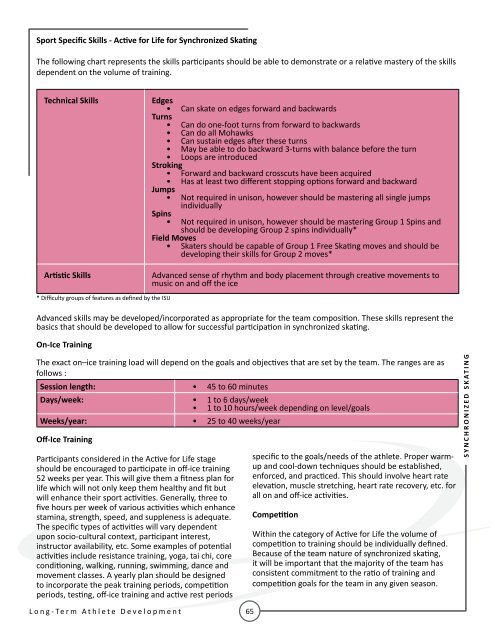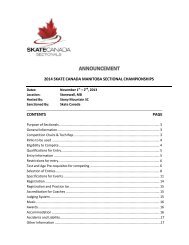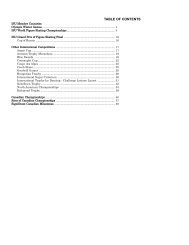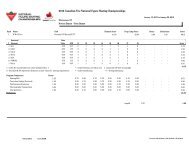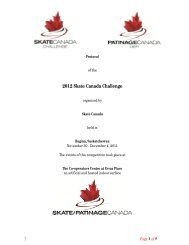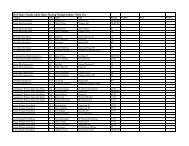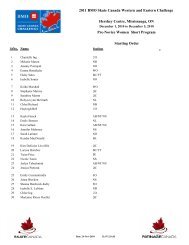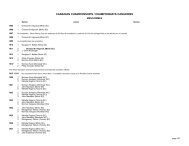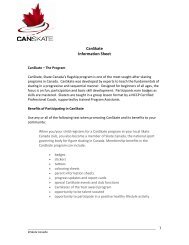LONG-TERM ATHLETE DEVELOPMENT - Skate Canada
LONG-TERM ATHLETE DEVELOPMENT - Skate Canada
LONG-TERM ATHLETE DEVELOPMENT - Skate Canada
You also want an ePaper? Increase the reach of your titles
YUMPU automatically turns print PDFs into web optimized ePapers that Google loves.
Sport Specific Skills - Active for Life for Synchronized Skating<br />
L o n g - Te r m A t h l e t e D e v e l o p m e n t<br />
65<br />
865 Sheord Road, Ottawa, Ontario K1J 1H9<br />
The following chart represents the skills participants should be able to demonstrate or a relative mastery of the skills<br />
Phone 613.747.1007 I Toll Free 1.888.747.2372 I Fax 613.748.5718 I Toll Free Fax 1.877.211.2372<br />
dependent on the volume of training.<br />
Technical Skills Edges<br />
• Can skate on edges forward and backwards<br />
Turns • Can do one-foot turns from forward to backwards<br />
• Can do all Mohawks<br />
• Can sustain edges after these turns<br />
• May be able to do backward 3-turns with balance before the turn<br />
• Loops are introduced<br />
Stroking<br />
• Forward and backward crosscuts have been acquired<br />
• Has at least two different stopping options forward and backward<br />
Jumps<br />
• Not required in unison, however should be mastering all single jumps<br />
individually<br />
Spins • Not required in unison, however should be mastering Group 1 Spins and<br />
should be developing Group 2 spins individually*<br />
Field Moves<br />
• <strong>Skate</strong>rs should be capable of Group 1 Free Skating moves and should be<br />
developing their skills for Group 2 moves*<br />
Artistic Skills Advanced sense of rhythm and body placement through creative movements to<br />
music on and off the ice<br />
* Difficulty groups of features as defined by the ISU<br />
Advanced skills may be developed/incorporated as appropriate for the team composition. These skills represent the<br />
basics that should be developed to allow for successful participation in synchronized skating.<br />
On-Ice Training<br />
The exact on–ice training load will depend on the goals and objectives that are set by the team. The ranges are as<br />
follows :<br />
Session length: • 45 to 60 minutes<br />
Days/week: •<br />
•<br />
1 to 6 days/week<br />
1 to 10 hours/week depending on level/goals<br />
Weeks/year: • 25 to 40 weeks/year<br />
Off-Ice Training<br />
Participants considered in the Active for Life stage<br />
should be encouraged to participate in off-ice training<br />
52 weeks per year. This will give them a fitness plan for<br />
life which will not only keep them healthy and fit but<br />
will enhance their sport activities. Generally, three to<br />
five hours per week of various activities which enhance<br />
stamina, strength, speed, and suppleness is adequate.<br />
The specific types of activities will vary dependent<br />
upon socio-cultural context, participant interest,<br />
instructor availability, etc. Some examples of potential<br />
activities include resistance training, yoga, tai chi, core<br />
conditioning, walking, running, swimming, dance and<br />
movement classes. A yearly plan should be designed<br />
to incorporate the peak training periods, competition<br />
periods, testing, off-ice training and active rest periods<br />
specific to the goals/needs of the athlete. Proper warmup<br />
and cool-down techniques should be established,<br />
enforced, and practiced. This should involve heart rate<br />
elevation, muscle stretching, heart rate recovery, etc. for<br />
all on and off-ice activities.<br />
Competition<br />
Within the category of Active for Life the volume of<br />
competition to training should be individually defined.<br />
Because of the team nature of synchronized skating,<br />
it will be important that the majority of the team has<br />
consistent commitment to the ratio of training and<br />
competition goals for the team in any given season.<br />
S Y N C H R O N I Z E D S K A T I N G


